Presently, commercial energy (that is energy we pay for, which excludes wood, that is often directly picked by the consumer and therefore does not go through a commercial circuit) consumed in the world is composed of oil, natural gas and coal for over 85%, all energies that lead to carbon dioxide (CO2) emissions when used.

breakdown by nature of the total primary energy consumption of the world in 2012. Electricity is converted on the base of the primary energy equivalent.
Source BP Statistical Review, 2013
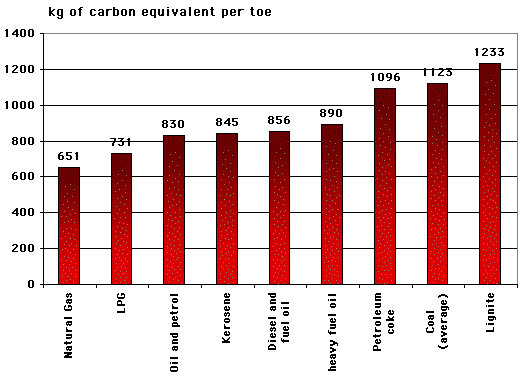
greenhouse gases emissions per ton of oil equivalent or toe (1 toe = 11600 kWh = the energy freed by the combustion of one ton of oil)
Note that the natural gas is not “clean”: its combustion does free only half the CO2 that coal frees for the same energy, but that’s not zero!
Source : ADEME.
But if we want to stop to enrich the atmosphere in CO2, what is a non negociable prerequisite to halt the climate change, we need to divide the world emissions by two at least. How can we meet this goal?:
- nWe may divide the fossil fuels consumption by two, by substituting half of our present consumption with energy savings and/or renewables and/or nuclear energy,
- we go on consuming the same amount of fossil fuels than today “as long as we can”, but we manage to avoid to send the resulting CO2 in the atmosphere. This is what this page is about.
- there is also the possibility (on the paper) to accelerate the natural carbon sinks, for example by planting trees. The corresponding potential is examined on another page.
Of course, we could make wathever combinaison we like of the three possibilities. Incidentally, we may note that saving energy, everybody heard of it, but maybe everybody did not truly understand what it means ! Indeed, in first approximation, saving energy, fossil or not, means using less energy to heat houses (and therefore having smaller or better insulated houses, or lowering the inner temperature), less energy to move (and therefore fly much less and drive less), having less household appliances (and lifts!), and at last buying much less manufactured products. It’s not exactely just changing a conventional light bulb for an economical one….
But let’s come back to CO2 sequestration. What is it about exactely? In practical terms, this “sequestration” designates the following operations:
- When a fossil fuel is burnt, the exhaust fumes go through a device that “captures” the CO2 (generally the exhaust fumes are injected into a liquid in which the CO2 dissolves, then the liquid loaded with CO2 is moved elsewhere where the CO2 is recovered),
- this CO2 extracted from the fumes is compressed, then injected – after having been transported in a kind of pipe if necessary – deep under the ground. The eligible receptables must of course have the property of not letting the CO2 escape back to the atmosphere later on. The following places are considered or experienced:
- former salt mines, hermetically shut,
- deep saline aquifers (that is deep layers of salted water), where the CO2 is dissolved into water,
- former oil or natural gas reservoirs (in this case the CO2 can be used to force the remaining oil out),
- in coal seams that are not considered suitable for production (the CO2 would adsorb in the place of methane),
- and more generally any airtight geological reservoir, because the idea of the game is obviously that this CO2 does not wander around after having been put in it!
What are the benefits of this process ?
The obvious benefit is of course that we would perturbate less the climate with a constant fossil fuel use. There is in particular a fossil fuel for which this sequestration might prove very interesting, it’s coal, that represents 2/3 of the proven reserves of fossil fuels on earth (graph below).
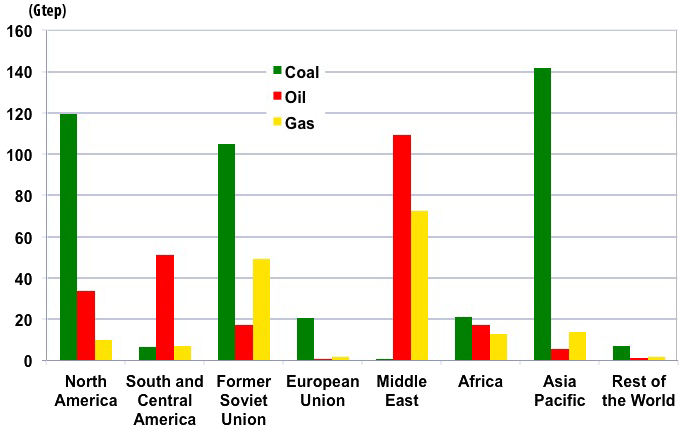
Breakdown by geographical region of the fossil fuel reserves, in Billions of tonnes of oil equivalent (Btoe in short ; see previous frame for the definition of a toe).
Source : BP Statistical Review, 2013.
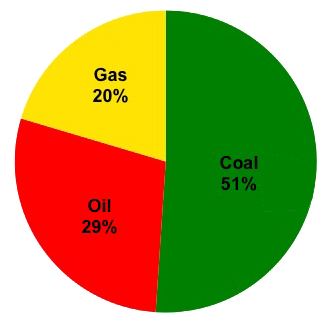
Breakdown by nature of the world reserves for the various fossil fuels.
A look at these graphs allows to note the following:
- Coal reserves are much better dispatched among regions than oil and gas reverves, even though 6 countries only concentrate more than 80% of the total (USA, Russia, India, China, Australia, South Africa),
- The heavy energy consumers (today Northern America and Europe, and tomorrow maybe Asia) all have very significant coal reserves nearby, when their oil and gas reserves are close to exhaustion,
- In particular the US have the first coal reserves in the world: their interest in investigating seriously the possibilities of CO2 sequestration techniques can be easily understood!
Still, it remains that burning all coal, gas and oil containded in the proven reserves, while sending all the CO2 in the atmosphere, would lead to over 750 ppm (parts per million) of CO2 in the atmosphere. A possible 4 to 8°C temperature increase might follow (the highest value includes a possible release from the natural sinks) that would lead to a major turmoil.
Source : BP statistical review 2013.
By other respects, the two dominant uses of coal are steel production (coal is used to reduce the iron oxydes found in the ore) and electricity production (graphs below).
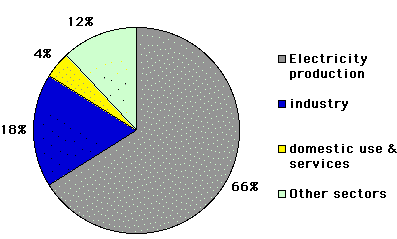
Breakdown by usage of the coal consumed in the world in 2000 (total: 2,36 billion toe).
Steel production composes most of the “industry” part.
Source : International Energy Agency
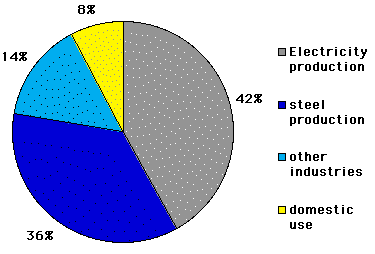
Breakdown by usage of the coal consumed in France in 2002.
The higher proportion of steel production is the consequence of a low usage for electricity production (5% of the electricity is coal produced in France where it is close to 50% for the OECD countries as a whole).
Source : Observatoire de l’Energie, Ministère de l’Industrie
These uses (electricity and steel production) have a characteristic in common: they lead to very “concentrated” emissions, that is emissions that are massive where then happen but restricted to a small number of places (steel mills and power plants). It is then conceivable to capture the CO2 emitted at those locations to send it underground afterwards, where, we can hope so, we won’t heard of it any more.
Though not identical, the breakdown for gas usages has similarities with that of coal, gas being used for a significant part for electricity production in the world, so that the corresponding emissions could also be “captured” in order to be put in a big hole where they would leave us in peace.
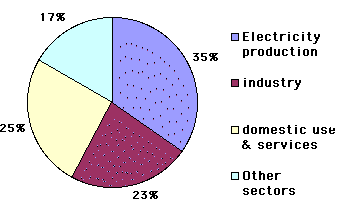
Breakdown by usage of the gas consumed in the world in 2000.
The “electricity production” share corresponds to a restricted number of massive emitters, and part of the “industry” share has the same structure.
Source : International Energy Agency
If we put end to end all the “concentrated” uses of fossil fuels, that principally take place in power plants and raw material production plants (plants that produce steel and other metals, cement, glass, basic chemical products and plastics…), we come close to something like half of the world emissions of CO2 coming from fossil fuel use.
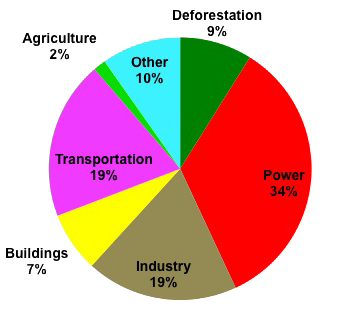
Breakdown by sector of the world CO2 emissions coming from fossil fuel use in 2012.
The emissions of the majority of electricity production, of all refining, and of 80% of industry are caused by a restricted number of intensive sources, and therefore eligible for a capture and sequestration process.
Sources : Compilation of the author on various sources
Well, as we we saw above that world emissions should be divided by two to stop perturbating the climate, haven’t we found a silver bullet there?
Everything perfect in a brave new world, then?
After having seen a “half full” bottle, we now ought to realize that it is also “half empty”. CO2 sequestration has also several weaknesses, that may be listed as follows :
- the first problem of this technique is simply that it remains very experimental. It has been used full scale in an oil field to expell more quickly the remaining oil, and there is one case of storage in a saline aquifer, to evacuate the CO2 produced by an oil rig in the North Sea (roughly 1 million tonnes of CO2 per year).
- The second inconvenient is that, here as elsewhere, to equip the integrality of eligible sources would require a time closer to a couple of decades than to a couple of months! “Waiting” to have this technology at hand to mitigate emissions is to accept, in a way, that emissions can increase as long as this possibility is not largely withspread (this is probably not very far from the position of some governments, though),
- the third inconvenient is that to purify the exhaust fumes, compress the removed CO2 (to transport it) and put it underground, it is necessary to use energy, and the commonly available figures expose that this whole chain requires a couple of tenths of % of the primary energy obtained from burning the fuel. In other terms, when we burn coal, oil or gas, instead of having 100% of the combustion energy available when we let the CO2 escape to the atmosphere, we only have 70 to 80% left, the remainder being used to send the CO2 in the subsoil. This has two major consequences:
- If we want to use all the fossil fuels presently underground without sending the CO2 into the atmosphere, it arithmetically cuts the reserves (or more exactely the net energy included in these reserves) by 20 or 30% (because 20% to 30% of these reserves has to be affected to CO2 sequestration no matter what), well at the present rate of increase of the consumption, and without sequestration, these reserves will be exhausted in half a century,
- any fossil fuel use with sequestration will necessarily be more expensive than without, as long as there will be no tax on CO2 emissions. A significant part of the coal being used either in the US, a country in which extra costs for a collective benefit are not always compatible with the common way of thinking, or in industrializing countries, that perhaps won’t have the necessary money to equip themselves with such device, it is not guaranteed that every eligible source would be equipped,
- in the particular case of electricity production, the “liberalization” that is happening everywhere will result in the fact that every extra cent on the production cost per kWh is seen as the devil by producers, that will fight against as hard as they can.
- The fourth inconvenient is that only “concentrated” emissions sources are eligible. It does represent half of the total CO2 emissions coming from energy use, but for the other half it is not possible to use this possibility. This therefore eliminates:
- transportation, which is rapidely rising (air transportation, the most intensive in fuel consumption per passenger, has the highest growth rate of all transportation means),
- all domestic uses, including all central heatings,
- “small” industrial plants.
- and a last limitation is that the CO2 coming from energy use represents only a fat 50% of the problem.
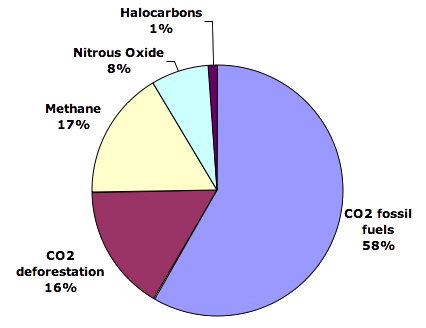
Breakdown of the human induced greenhouse gases emissions, by gas, ozone excluded (because it has no direct source), in millions of tonnes of carbon equivalent.
The contribution of ozone to radiative forcing being not far from that of methane, it can be stated that CO2 coming from fossil fuel use represents roughly 50% of the climate perturbation of human origin.
Source : IPCC, 2007
As a consequence, sequestrating 50% of 50% of our emissions would allow to get rid of 25% of the total. This is certainly not to neglect (oh no!), but it won’t be enough to get rid of any possible future trouble, particularly if the world energy consumption is multiplied by 4 in the meanwhile with the same “energy mix” than the one we have today (that is 85% for fossil fuels, and 15% for the “carbon free” sources that are mostly hydroelectricity and nuclear). In other words, if 7 to 9 billion human beings have the energy consumption of a 2012 European, with the same mix, greenhouse gases emissions (before any sequestration) will be multiplied by 4.
It means that even if sequestration becomes technically fit, widely spread, so that it allows to avoid half of the CO2 emissions coming from electricity generation and heavy industries, if we still want more and more energy overall, we would end with emissions four times too important to stabilize the amount of CO2 in the air. Sequestration is therefore at the same time a major mitigation possibility and something insufficient to avoid any other effort regarding energy savings or a modification of the “mix”.